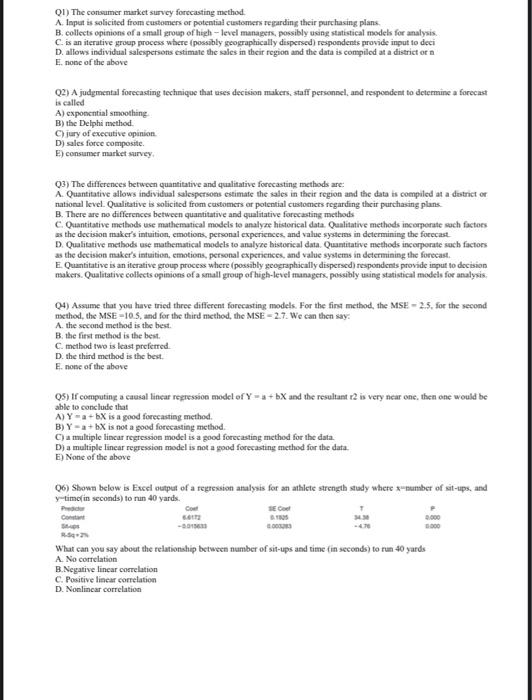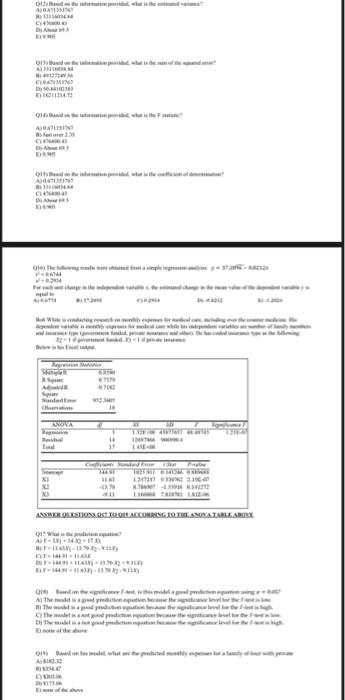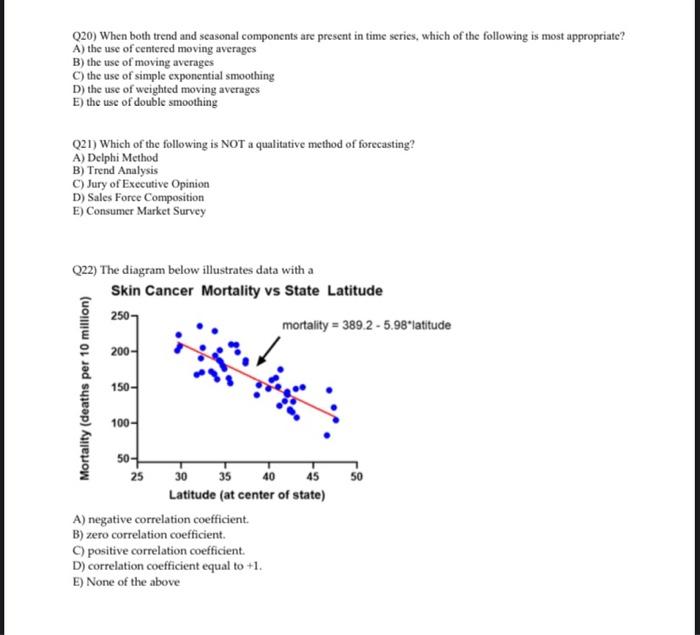C. ane of thes cein D. nem of then I. 111in in Fealis A norer el titem Agas?13074? Dy Ahod bes arderation 4 byseresess. 5igrist4.72 A. as heswer t th Criteksial. Co Almetert Aitionth D* anta a. a.jes A. 51532 Exipes Q20) When both trend and seasonal components are present in time series, which of the following is most appropriate? A) the use of centered moving averages B) the use of moving averages C) the use of simple exponential smoothing D) the use of weighted moving averages E) the use of double smoothing Q21) Which of the following is NOT a qualitative method of forecasting? A) Delphi Method B) Trend Analysis C) Jury of Executive Opinion D) Sales Force Composition E) Consumer Market Survey Q22) The diagram below illustrates data with a A) negative correlation coefficient. B) zero correlation coefficient. C) positive correlation coefficient. D) correlation coefficient equal to +1 . E) None of the above Q1) The consumer market survey forccasting method. A. Input is solicited from customers or potential customers regarding their purchasing plans. B. collects opinions of a small group of high - level managers, possibly using statistical models for analysis. C. is an iterative group process where (possibly geographically dispersed) respondents provide input to deci D. allows individual salespersons cstimate the soles in their region and the data is complled at a district or a E. nooc of the above Q2) A judgmental forecasting technique that uses decision makers, staff personnel, and respendent to determine a forecast is called A) exponcntial smoothing. B) the Delphi method. C) jury of executive opinion. D) sales force composite. E) consumer market survey. Q3) The differences between guantitative and qualitative forceasting methods are: A. Quantitative allows individual salespersoes estimate the sales in their fegion and the data is compiled at a destrict or national level. Qualitative is solicited from customers of potential customers regarfing their purchasing plans. B. There are no differences between quantitative and qualitative forecasting methods C. Quantitative methods use mathematical models to analyze historical data. Qualitative methods incorporate sach factoes as the decision maker's intuition, emotions, personal experiences, and value systerns in determining the focecast. D. Qualitative methods use mathematical models to analyze bistorical data. Quantitative methods incorporate such factors as the decision maker's intuition, emotions, personal experiences, and value systems in determining the forceast. E. Quantitative is an itcrative group process where (possibly geographically dispersed) respondenis provide input to docision makers. Qualitative collects opinions of a small group of high-level managerx, possibly uaing statistical models for analyxis. Q4) Assume that you have tried three different forecasting models. For the fins method, the MSE =2.5, for the second method, the MSE =10.5, and for the third method, the MSE =2.7. We can then say: A. the second method is the best. B. the first method is the best. C. method two is least preferred. D. the third method is the best. E. nose of the above Q5) If computing a casisal linear recressioe model of Y=a+bX and the resultant r is very near one, then one would be able to conclude that A) Y=a+bX is a good forecasting method. B) Y=a+bX is not a good forteasting method. C) a maltiple lincar regression model is a good forecasting method for the data. D) a multiple linear regression model is not a good forecasting method for the data. E) None of the above Q6) Stown below is Excel output of a regrexsion analysis for an athlete strength stady where s-number of sit-ups, and y - time( in seconds) to run 40 yards. A. No corriclation B.Negative linear cortelation C. Positive linear correlation D. Nonlincar correlation










